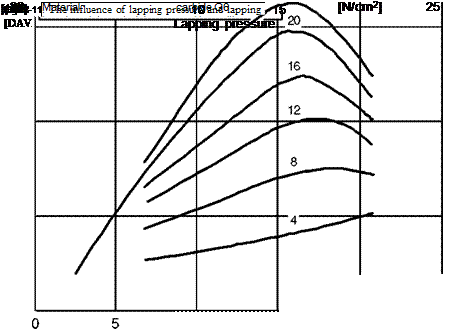As discussed above, the lapping process is influenced by numerous technologically-based marginal conditions. An overview of these is given in Fig. 8-10.
|
Kinematics |
Lapping plate |
Slurry |
Machine |
Workpieces |
|
• Rotational |
• Material |
• Grain material |
• Normal force |
• Material |
|
speeds |
• Slot configu- |
• Grain size |
• Machine |
• Geometry |
|
• Dimensions |
ration and |
distribution |
power |
• Thickness |
|
• Carrier configuration |
geometry • Evenness |
• Carrier fluid • Concentration • Volume flow |
• Oscillation behaviour • Thermal stability |
distribution |
 |
Lapping result
Fig. 8-10. Influence and output variables in lapping
Kinematics partially determine the disc shape and evenness and the disc material. It also determines how lapping slurry is distributed and how the grain is used and dictates the required machine design. Kinematics is also closely interdependent with workpiece geometry. Similarly far-reaching interconnections can be demonstrated for the other marginal conditions, as well.
Lapping pressure and lapping speed can be seen as the main variables in the lapping process. Since lapping is a force-bound process, the workpiece feed rate and the removal rate cannot be adjusted directly. These depend on the marginal conditions, i. e. the process variables.
Lapping pressure plays a large role in the material removal rate. With increasing lapping grain diameter, the material removal rate also increases [MATS66, MART73].
It is clear from Fig. 8-11 that the material removal rate rises constantly given identical lapping durations up to a load of approximately 16 N/cm2, a further increase in lapping pressure, however, causes the material removal rate to sink. This course of events can be ascribed to the breaking of the lapping grains added at the
beginning of operation. This kind of process thus involves an optimal lapping pressure which one in consideration of economical factors should not fall short of.
|
га > — U О ф* си |

The material removal rate also decreases with an increasing lapping disc rotational speed, but there is a limit to how much this variable can be increased. Above all, excessive centrifugal forces would convey the lapping slurry too quickly from the active zone to the edge of the disc. In addition, the levelness and planar parallelism of tall workpieces which tend to wobble can be unfavourably influenced by this.
